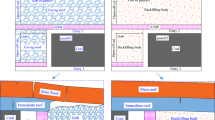Abstract
Room-pillar technology is the main method used for underground gypsum resource mining. A large area of mined gob with a hanging roof is formed by continuous gypsum rock pillars, which continue to creep until failure occurs due to the long-term load of overlying strata. Once failure occurs, the gypsum-mined gob collapses suddenly and induces a serious dynamic mining disaster. In this study, using the creep experiment of gypsum rocks, a creep curve and the characteristics under the condition of a graded load were obtained. Furthermore, a creep model of the gypsum rock was established based on the creep experimental results. New FLAC numerical calculation models of gypsum-mined gob were established by inputting a creep model into the software for secondary development. Moreover, the stress distribution and plastic zone evolution of the gypsum rock pillars were analyzed. Finally, the mechanism of gypsum-mined gob collapse was revealed, and the lagging time was predicted. The results of this study are important for clarifying the lagging collapse mechanism of gypsum-mined gobs with rock creep.















Similar content being viewed by others
Data Availability
The data used to support the study is all included in the article.
References
Chen D, Wang E, Li N, Wang X (2018) Study on the fracture and the law of temporal-spatial evolution of acoustic emission of gypsum and sandstone specimens. J China Coal Soc 43(7):1902–1909
Guo Y, Yang C (2010) Experimental investigation on strength and deformation properties of anhydrite under conventional triaxial compression. Rock Soil Mech 31(6):1776–1780
He G, Li F, Tao Q (2018) Experimental investigation on rheological mechanical properties of the gypsum sample under step loading and its application. J Univ South China (sci Technol) 32(5):27–33
He M, Liu D, Gong W, Wang C, Kong J (2014) Development of a testing system for impact rockbursts. China J Rock Mech & Eng 33(9):1729–1739
He R, Han Z, Zhou Y, Liu H, Liu Y (2020) Analysis on disaster characteristics and preventive measures of goaf in metal and non-metal mines. Min Resour Dev 40(9):33–38
Jiang X, Chen C, Xia K, Liu X, Zhou Y (2016) Experimental study of creep characteristics of gypsum mine rock in triaxial compression. Rock Soil Mech 37(S1):301–308
Li X, Zhou Y, Wang M (2018) Research on the relationship between hysteresis loop and damage performance of gypsum under cyclic loading. J Exp Mech 33(2):194–200
Liu Z, Zheng H, Li M (2019) Experimental research on creep failure characteristics of gypsum rock based on rock longitudinal wave velocity. Geotech Geol Eng 37(3):1515–1522
Song Z, Wang J, Ren G, Lv J, Qian Z (2015) Research on rule and control of mining damage from goaf in the gypsum mine. Indu Saf Environ Prot 41(12):26–28
Wang S, Liu Y, Chen X, Yang Q (2019) Failure analysis of pre-cracked specimen based on acoustic emission technique. J Hydro Eng 38(7):110–120
Wang Z, Ai C, Tang M (2009) Complete process of rock creep in different stress states. J China Coal Soc 4(2):169–174
Yang H, Chu R, Sheng H (2018) Source characterization of the 2015 gypsum mining earthquake in Pingyi, Shandong. Prog Geophys 33(1):125–132
Yang Y, Xing L, Zhang Y, Ma D (2015) Analysis of long-term stability of gypsum pillars based on creep tests. China J Rock Mech Eng 34(10):2106–2113
Zhang G, Li H, Wang M, Li J, Deng S (2019) Comparative study on damage characterization and damage evolution of rock under uniaxial compression. China J Geotech Eng 41(6):1074–1082
Zheng H, Hou X, Liu Z, Li B, Li H (2017) Disturbance mechanism of rock deformation based on energy accumulation. Indus Min Process 46(12):44–49
Zhu Y, Huang X, Guo J, Xiao F, Zhao F (2017) Experimental study of fatigue characteristics of gypsum rock under cyclic loading. China J Rock Mech Eng 36(4):940–952
Acknowledgements
This research was supported by National Natural Science Foundation of China (51904177).
Author information
Authors and Affiliations
Contributions
SW carried out experiment and wrote the paper. WL carried out field work. ZL made numerical simulation. HZ analyzed experimental results.
Corresponding author
Ethics declarations
Conflict of interest
The author declares no conflicts of interest.
Additional information
Publisher's Note
Springer Nature remains neutral with regard to jurisdictional claims in published maps and institutional affiliations.
Rights and permissions
About this article
Cite this article
Wang, S., Lv, W., Liu, Z. et al. Lagging Collapse Mechanism of Gypsum-Mined Gob with Rock Creep. Geotech Geol Eng 40, 2489–2499 (2022). https://doi.org/10.1007/s10706-021-02040-2
Received:
Accepted:
Published:
Issue Date:
DOI: https://doi.org/10.1007/s10706-021-02040-2




